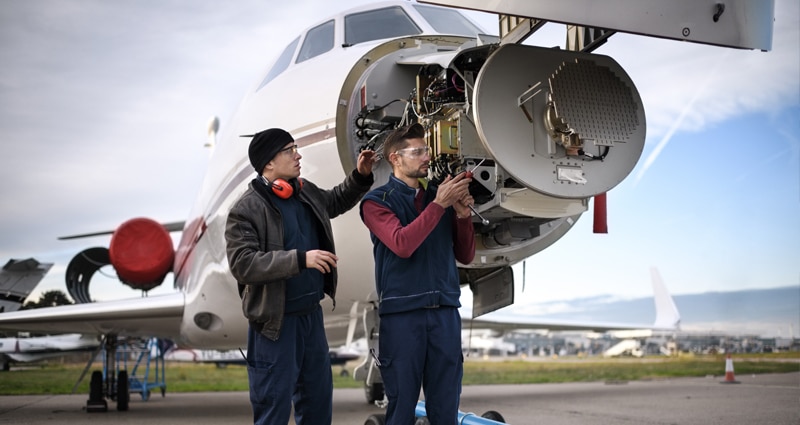Train Smarter: The Benefit of an Annual Training Program Analysis

Training programs are an investment of both money and employee resources (time). Training can be used to improve employees’ skills, expand an individual’s knowledge to a new topic, highlight changes, raise awareness to create a point of emphasis, improve efficiency, manage risk or simply to ensure compliance.
The good news is that the regulated training minimums for a typical Part 91 operation are very little. The FAA gives you much discretion in determining what training is necessary for you to manage risks. (Note: Insurance companies may encourage or require more training beyond the regulated minimums.)
For a Part 135 operator, the FAA-mandated list of training requirements certainly increases. However, you still have the latitude to determine the method of training, what specific content to deliver and what additional training may be appropriate to adequately manage risk.
Training and Budget Constraints
When managing training within a budget, price can become a primary factor over efficiency and effectiveness. It is not a good value to simply train to check a box and not provide meaningful content. Measuring the effectiveness of training is a critical piece in the instructional system design process.
A training program can be optimized to fit your budget and be effective. When we do a training program analysis at Advanced Aircrew Academy, we typically make as many recommendations to remove training or extend a recurrent training interval as we do to add training to address identified hazards. Train on this, not that.
If you overtrain or provide training that is not relevant, employees will tune out and be less likely to engage with future training content to apply the information and change behaviors. Ideally, you want to provide the training at the right time, to the right person with the right content.
Defining Your Training Needs
Training program analysis for a business aviation operator should include a review of the following items (as applicable and available):
- Type of operation, areas of operation, aircraft types and flight department organization
- Training program documentation (Operations Manual and/or Training Manual)
- Company safety risk profile, safety performance indicators and hazard reports
- Parent company training requirements such as those directed from human resources on topics like harassment or employee assistance program
- Training requirements associated with FAA Operation Specifications (Part 135) or Letters of Authorization (LOA) (Part 91)
- Internal and external audit findings
- FAA special emphasis items
- National Transportation Safety Board (NTSB) Most Wanted List
- National Business Aviation Association (NBAA) Management Guide training recommendations
- IS-BAO training requirements and recommendations (if IS-BAO registered or seeking IS-BAO registration)
- Business Aviation Safety Consortium (BASC) International Civil Aviation Organization (ICAO) training requirements (if a BASC member or seeking BASC membership)
- Job-role-specific duties and responsibilities related to federal and state occupational safety and health regulations
The output of the analysis is a summary of training requirements and recommendations, with frequency of recurrent training, organized by topic.
The analysis is designed to inform and guide strategic refinement to the overall training plan. A combination of in-house resources along with content from third-party training organizations can be utilized to optimize the training program.
Training Program Trends
What are the top trends that we see when conducting training program analysis?
- Dangerous Goods training is only required every 24 months, not annually (ICAO, IS-BAO Chapter 8, CFR 135.501).
- Part 135 does not require every topic from initial to be trained every year (8900.1 Volume 3 Chapter 19).
- The FAA removed the training requirement for ADS-B. Unless you have a specific need to still train on it, it likely can be removed from your plan.
- Occupational Safety and Health training can be aligned to CFR 1910 and a job task analysis of workplace hazard exposure for each role in the flight department.
- NBAA Management Guide and IS-BAO provide good benchmarks for industry best practices for training topics.
- The NBAA Safety Committee’s Top Preventable Accidents that can be mitigated with training are Loss of Control Inflight, Runway Excursions, Controlled Flight Into Terrain, and Maintenance and Ground Incidents.
The review and analysis process does take time and effort. However, the benefits are an improved training program that optimizes your training budget, grows your safety margins and is respectful of your team members’ time.

Advanced Aircrew Academy offers over 120 eLearning modules, several of which address Worldwide International Procedures and Aircraft Security, that can be customized for your specific flight department operations.
https://www.aircrewacademy.com/
© 2025 Advanced Aircrew Academy. All Rights Reserved.
Next ArticleRelated Posts

Navigating Geopolitical Uncertainty Using Business Aviation
Bigger business jets mean bigger fuel tanks, longer trips, more border crossings, and bigger wallets! With an equipment upgrade also comes the requirement for a knowledge upgrade.

Leadership, Accountability and Your Organization’s Risk Profile
Recent media attention has cast light on the unusual number of aviation system-related accidents, incidents and near-misses that have plagued our industry over the past several months.
